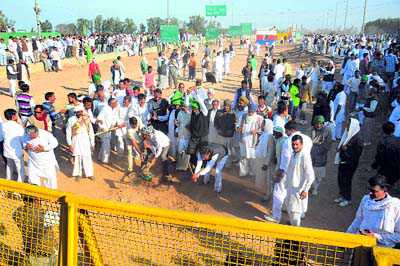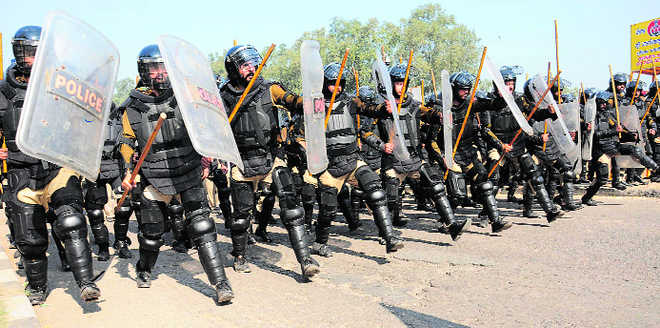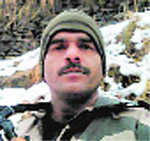
VVPATs had developed a snag at some places
KV Prasad
Tribune News Service
New Delhi, February 7
The Election Commission on Tuesday announced repolling in 48 polling stations falling in Majitha, Muktsar and Sangrur assembly segments in Punjab. It will be held on February 9, Thursday.At many polling stations, the VVPATs and EVMs had reportedly developed a snag.The repolling will be held at 16 polling stations for the Amritsar Lok Sabha seat.
(Follow The Tribune on Facebook; and Twitter @thetribunechd)
Also read: Why repolling when we don’t want it: Bikram Singh MajithiaAs far as Assembly seats are concerned, it will be held at 12 polling stations in Majitha, one in Moga, nine in Muktsar, four in Sardulgarh and six polling stations in Sangrur.The repolling will be held from 8 am to 5 pm.The EC order said the repolling would uphold the integrity of the electoral process.
The Election Commission said that at some places polling was interrupted as VVPAT machines and EVMs had malfunctioned. Of 24,697 Ballot Units and 24,256 Control Units used in Punjab 180 BUs and 184 CUs failed during the poll, the EC added.
The Election Commission had even sought a report from the state election authorities about the malfunctioning of VVPATs which caused delayed in voting.After VVPATs developed snag, AAP national convener and Delhi Chief Minister had attacked the Election Commission and tweeted, “Never has any election seen malfunctioning EVMs on such a large scale. Was it mischief done deliberately by or in collusion with EC?”AAP leader Sanjay Singh had even raised the matter with Punjab CEO, demanding extension in time where polling was affected because of VVPAT problem.Voter verifiable paper audit trail (VVPAT) generates a receipt and allow people to verify if the vote went in favour of the candidate against whose name the button was pressed on the EVM. — With agency inputs
Why repolling when we don’t want it: Bikram Singh Majithia

Bikram Singh Majithia.
Jupinderjit Singh
Tribune News Service
Chandigarh, February 7
The Election Commission on Tuesday drew flak from leaders over the issue of repolling in 48 polling stations falling in Majitha, Muktsar and Sangrur Assembly segments following malfunctioning in the Voter-Verified Audit Paper Trail (VVPAT) and EVMs on February 4.The repolling will take place on February 9.
(Follow The Tribune on Facebook; and Twitter @thetribunechd)
Akali candidate Bikram Singh Majithia from Majitha constituency said he was surprised that the EC had ordered repolling as most of the booths listed had recorded upto 90 per cent votes.”I don’t understand the logic behind the repolling. On poll day, we sought extension of time for voting due to a snag in the VVPAT machines. It was denied. Now after three days, the repolling has been ordered. It is a one-way communication. The EC needs to explain. None of the candidates in Majitha had sought repolling,” he said. Majithia said they had said no for repolling after the EC had sought a report from the state election authorities on the malfunctioning of VVPATs, which caused delay in voting.SAD rebel Sukhdarshan Singh Mrar, who contested as an Independent from Muktsar, said: “There is no need for repolling. When no candidate has raised any objection then why the EC has ordered repolling.”
On repoll in Majitha, AAP candiadate Himmat Singh Shergill said he would start doing door to door campaign in the areas that will go to polls again.
He said: I don’t want to comment on EC orders. It is done now. I don’t want to waste even one minute of my door to door campaigning. I was winning the seat. The repoll will increase the victory margin.”Meanwhile, the Sangrur DC has called a meeting of officers to prepare for repolling.AAP national convener and Delhi Chief Minister Arvind Kejriwal had on Saturday attacked the Election Commission and tweeted, “Never has any election seen malfunctioning EVMs on such a largescale. Was it mischief done deliberately by or in collusion with EC.”AAP leader Sanjay Singh had raised the matter with the Punjab CEO, demanding extension in time where polling was affected because of the VVPAT problem.
Challenge of a third player in Punjab politics
Pritam Singh
In Punjab, the AAP has risen as a third alternative on the ruins of Punjab’s parliamentary Left, the brutal suppression of the Naxalite movement in the early 1970s and the Sikh militant movement in the 1990s. The AAP has given a political platform to those who were alienated from both the Congress and the SAD.
POLL FURY: AAP supporters during a roadshow while campaigning in Amritsar. Tribune Photo: Vishal Kumar
PUNJAB’S election scene was both annoying and fascinating. It was annoying because confronted with the enormity of the task Punjab faces due to its stunted development, we saw cheap tricks, theatrics and personal insults in the course of electioneering. One must appreciate at least two political leaders, Parkash Singh Badal and Dharamvir Gandhi, who thankfully stuck to civilised language and decorum during campaigning for the polls. Despite this annoyance, the election scene was still fascinating because for the first time, the duopoly of political rule in Punjab has been challenged by a third player, that is the Aam Aadmi Party (AAP). This will, hopefully, strengthen democracy by enabling Punjabis to widen their political choices and not be forced to choose only between two rivals — the Shiromani Akali Dal and the Congress party.Historically, once there did emerge the possibility of a Left alternative, in the 1950s and in a modified form until 1980. In the 1957 assembly elections in the erstwhile Punjab, 13.6 per cent voters had voted for the Communist Party and 1.3 per cent for the Praja Socialist Party, thus taking the combined Left vote to 15 per cent. If we confine ourselves only to the constituencies which fall in the present-day Punjab, this vote was around 25 per cent. Every fourth voter had then voted for the Left. Outside parliamentary politics, the Naxalite movement in Punjab in the late 1960s and the early 1970s attracted the brightest and idealistic Punjabi youth to its fold. The parliamentary Left too maintained a good position so much so that for the Assembly elections in 1980, the Akali Dal-CPI-CPM combine narrowly missed capturing power in Punjab. It is tempting to imagine that had that coalition won, the politics of Punjab might have followed a different historical course with consequences for Indian politics. Until then, the Punjabi Leftists were reasonably successful in combining their roots in Punjab’s egalitarian Sikh traditions with modern socialism. The parliamentary Left damaged itself after 1984 when instead of following its reputable political philosophy of standing with the oppressed; it became an ally of the establishment while there were massive human rights violations taking place in the rural areas of Punjab. Every movement has its soul and when that soul is lost, the death of the movement is inevitable. The degeneration of the parliamentary Left leadership led to its two elected CPI MLAs in 2002 being lured into the Congress by the then Chief Minister Amarinder Singh. The final demise of this Left alternative was symbolised by its complete absence in the Punjab legislature since 2007.The AAP has risen as a third alternative in Punjab on the ruins of Punjab’s parliamentary Left and the brutal suppression of the Naxalite movement in the early 1970s and of the Sikh militant movement in the 1990s. It is this specific Punjab link that is central to resolving the puzzle that a party with no Punjabi in its central leadership managed to win 4 out of 13 Lok Sabha seats from Punjab in 2014. It not only lost every seat it contested elsewhere in the country but 414 out of the 434 candidates fielded forfeited their security deposits. This stunning performance in Punjab also contributed significantly to its spectacular success in the Delhi Assembly elections in February, 2015. Then Left sympathisers and Sikh activists had actively campaigned for the AAP in Delhi.The suppression of the Naxalite movement in Punjab involved physical liquidation of nearly 100 activists in “encounters” and imprisonment, torture, abuse, harassment and monetary exploitation of thousands of sympathisers. The suppression of this movement left thousands of families broken, discontented, helpless and angry. This network of families and activists had virtually no political home in the existing political parties. The rise of the AAP since 2013/2014 has provided them a platform of hope. Unleashing of the dormant energies of these activists had played a crucial part in the AAP’s electoral victories in 2014, particularly in the Faridkot and Sangrur constituencies and to a lesser extent in the Patiala constituency where Dr Gandhi defeated the Congress candidate Perneet Kaur. These constituencies formed areas where the Naxalite movement had had a substantial following, especially among the youth.The suppression of the Sikh militant movement in the 1980s and 1990s was even wider and deeper than the Naxalite movement. It affected hundreds of thousands of families whose members were liquidated by the security forces or tortured, humiliated or subjected to extortion. A substantial section of the Sikh population was disgruntled and rebellious but without an obvious political home. At one stage, these angry masses supported the Simranjeet Singh Mann-led Akali Dal candidates, leading to massive victories of those candidates to the Lok Sabha in 1989. However, Mann’s inability to organise this support in a sustainable manner led to this discontented mass migrating almost en bloc in its support to the AAP. The election in 2014 of Harinder Singh Khalsa from Fatehgarh Sahib showed the strength of this stream of the AAP’s support base.The other components in the AAP’s support base include idealistic youth opposed to corruption from the urban Hindu middle class, a section of the Dalits and the diaspora. The AAP’s potential as a third alternative has been weakened by its organisational blunders such as expelling its founding Punjab convener Chhottepur and political blunders such as superimposing the image of the jharoo over that of Golden Temple in its publicity material. Despite these blunders, the AAP remains a substantial player in Punjab’s electoral politics. It does not have the organisational network that the Akali Dal has but it has fully exploited the Akali Dal’s vulnerability on the government’s mishandling of the desecrations of Shri Guru Granth Sahib. As far as the Congress is concerned, it has nothing to show except Amarinder Singh as a popular leader.One significant political outcome from the AAP’s foray into Punjab is that the issue of Punjab politics being governed by Punjab politicians and not Delhi-based centralised leaders has acquired a level of importance never seen before. All political parties are being forced to underplay the role of their central leaders and to project greater decision-making powers to their state-based leadership. Irrespective of the outcome of this Assembly election, the lasting and valuable contribution of the highly centralised AAP to Punjab would be, paradoxically, to strengthen the regionalisation of Punjab politics.The writer is a Professor of Economics at Oxford Brookes University, UK





























































































































